 This zingy soup came about thanks to a visit I made to Provence last summer. While staying with friends in St-Rémy during a break between lockdowns, I came across an old cookbook of regional dishes and was intrigued to see a blended potato-leek soup that may be served cold or hot. It looked like something you’d expect to see further north — like a Provençal version of vichyssoise, in which the cream was replaced by pistou.
This zingy soup came about thanks to a visit I made to Provence last summer. While staying with friends in St-Rémy during a break between lockdowns, I came across an old cookbook of regional dishes and was intrigued to see a blended potato-leek soup that may be served cold or hot. It looked like something you’d expect to see further north — like a Provençal version of vichyssoise, in which the cream was replaced by pistou.
Soupe provençale au basilic / Provençal soup with pistou
So this is a very different soup than its Provençal sibling, soupe au pistou, which is closer to minestrone with chunky veggies and pasta or beans. But the star ingredient in both is pistou — a blend of basil, garlic and olive oil, like Italy’s pesto minus the parmesan and pine nuts. As a big fan of pistou, I thought the soup sounded promising, so when I got back to Paris I made it. Good, but not great. So I tried again and improvised, adding zucchini to lighten the mix and add flavor. Success.
Served chilled and drizzled with extra pistou, this soup makes a delightful start to a summer meal. And if serving hot, you can bring a bowl of parmesan shavings to the table. They melt into the soup for an extra burst of flavor.
I’m writing this post from England, having come over as soon as the quarantine rules were lifted, and am having a fine time visiting friends and enjoying the local gastronomy. I’m also learning about conditions post-Brexit, some of which are affecting life in the kitchen. It turns out there’s a shortage of chicken due to the absence of the migrant workers who staffed the poultry farms over here. They’ve been sent back to Romania, Bulgaria, Poland and so on. The papers are also predicting a shortage of Christmas turkeys — a disaster given English traditions. And that’s not all. Lettuce is hard to find, presumably for the same reason, and friends report that shelves are bare in some supermarkets and pharmacies due to a lack of truck drivers, many of whom were also foreign.
The good news is that the British are continuing to produce local specialties that one can rarely enjoy in Paris. For example, a spread of potted brown shrimp and crabmeat, delicious on toast; baby peas in their tender pods served with aïoli; lightly spiced Cumberland sausages, quite different from French chipolatas; blackberry-plum cake, which would be impossible to make in France at the moment due to the absence from the market of blackberries; and fabulous local cheeses, such as Kingcott, a creamy blue with a light rind, and Winterdale Shaw, an aged hard cheese that is similar to cheddar.
Meantime I’ve updated the Menus section with everyday and weekend recipes for summer for omnivores, vegetarians and vegans. Enjoy, and see you in September.
Happy cooking.

 High summer is the time to make and enjoy this dish of roasted eggplant topped with a pungent walnut sauce. Traditionally served as a starter, it also makes a fine side dish or the star of a mezze spread. The walnuts are ground with garlic and fresh cilantro. Red wine vinegar and cayenne add tang, coriander seeds add spice, and celery adds a bit of crunch. It may not exactly be French — but it will have you saying ooh-là-là.
High summer is the time to make and enjoy this dish of roasted eggplant topped with a pungent walnut sauce. Traditionally served as a starter, it also makes a fine side dish or the star of a mezze spread. The walnuts are ground with garlic and fresh cilantro. Red wine vinegar and cayenne add tang, coriander seeds add spice, and celery adds a bit of crunch. It may not exactly be French — but it will have you saying ooh-là-là. Paupiettes de veau, a classic bistro dish, are veal scallops stuffed with a savory meat filling. They are rarely made from scratch in French homes as they can be bought already stuffed from the butcher — and merely need to be braised before serving. But as I discovered, they’re fun to make and easier than one might think. The veal is folder around ground meat flavored with onion, garlic and herbs, then barded with bacon and tied up with string.
Paupiettes de veau, a classic bistro dish, are veal scallops stuffed with a savory meat filling. They are rarely made from scratch in French homes as they can be bought already stuffed from the butcher — and merely need to be braised before serving. But as I discovered, they’re fun to make and easier than one might think. The veal is folder around ground meat flavored with onion, garlic and herbs, then barded with bacon and tied up with string.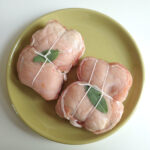 Preparation of paupiettes de veau begins by pounding the veal scallops to ensure they are thin enough to wrap around the stuffing. Tying them up is simple — it’s like wrapping a birthday present. Once stuffed, the paupiettes are browned on all sides and then braised in white wine or, sometimes, rosé.
Preparation of paupiettes de veau begins by pounding the veal scallops to ensure they are thin enough to wrap around the stuffing. Tying them up is simple — it’s like wrapping a birthday present. Once stuffed, the paupiettes are browned on all sides and then braised in white wine or, sometimes, rosé.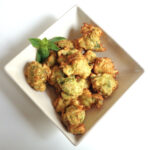 These light and crispy zucchini fritters are a French adaptation of a dish I discovered on a Greek island. Flavored with mint, dill, oregano and grated onion, they make a delightful start to a meal and may also be served at cocktail hour or as part of a mezze spread. Or you can serve them alongside grilled fish, meat, chicken or veggies. They marry extremely well with tzadziki. Add a bottle of chilled rosé, and you’ll feel like you’re in the Cyclades.
These light and crispy zucchini fritters are a French adaptation of a dish I discovered on a Greek island. Flavored with mint, dill, oregano and grated onion, they make a delightful start to a meal and may also be served at cocktail hour or as part of a mezze spread. Or you can serve them alongside grilled fish, meat, chicken or veggies. They marry extremely well with tzadziki. Add a bottle of chilled rosé, and you’ll feel like you’re in the Cyclades. So, on my second try with the zucchini fritters, I went with my instinct and folded a beaten egg white into the batter. Success! I made myself some tzadziki (see the bottom of
So, on my second try with the zucchini fritters, I went with my instinct and folded a beaten egg white into the batter. Success! I made myself some tzadziki (see the bottom of 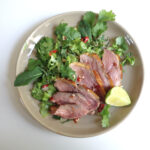 This Thai duck salad with French accents is a dish my friends ask for time and again when they come over. It combines Thai flavors — lemongrass, cilantro, Asian fish sauce, lime juice and red pepper — with the supremely French cut of duck known as magret, aka the breast, fat attached. The duck is cooked to a warm rosiness, then sliced and placed over or beside the herbal salad. Add a glass of chilled rosé, and lunch or dinner is ready.
This Thai duck salad with French accents is a dish my friends ask for time and again when they come over. It combines Thai flavors — lemongrass, cilantro, Asian fish sauce, lime juice and red pepper — with the supremely French cut of duck known as magret, aka the breast, fat attached. The duck is cooked to a warm rosiness, then sliced and placed over or beside the herbal salad. Add a glass of chilled rosé, and lunch or dinner is ready. This is a very unusual crumble in that the strawberries are not baked but rather piled fresh into a glass and layered with crumble baked separately, whipped cream and homemade caramel sauce. The result is a light, fresh spring/summer dessert that is as lovely to behold as it is to eat. I can tell you that the crumble in this photo was devoured in seconds by my daughter, and its twin by her boyfriend. And this all came about thanks to French TV…
This is a very unusual crumble in that the strawberries are not baked but rather piled fresh into a glass and layered with crumble baked separately, whipped cream and homemade caramel sauce. The result is a light, fresh spring/summer dessert that is as lovely to behold as it is to eat. I can tell you that the crumble in this photo was devoured in seconds by my daughter, and its twin by her boyfriend. And this all came about thanks to French TV… A lovely way to serve an omelet in springtime is with freshly shelled peas, with a scattering of mint and scallions for an extra burst of flavor. You can add cheese, ham or bacon, baby spinach or arugula — anything your palate desires. The omelet is light, fresh and ultraquick to prepare. Peas straight out of the pod need to be cooked for only a minute. Then whip the eggs, swirl them into the pan, and lunch can be on the table in just ten minutes.
A lovely way to serve an omelet in springtime is with freshly shelled peas, with a scattering of mint and scallions for an extra burst of flavor. You can add cheese, ham or bacon, baby spinach or arugula — anything your palate desires. The omelet is light, fresh and ultraquick to prepare. Peas straight out of the pod need to be cooked for only a minute. Then whip the eggs, swirl them into the pan, and lunch can be on the table in just ten minutes. My love of fresh peas translates into many other recipes:
My love of fresh peas translates into many other recipes: 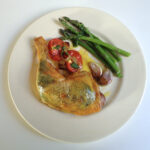 This dish of roast chicken with a garlicky basil sauce tucked under the skin was inspired by my friend Valérie, a superlative cook. It’s a spin-off from a venerable ancestor, poularde en demi-deuil, or ‘chicken in half mourning’, a specialty of Lyon in which truffle slices are slipped under the skin. As truffles are expensive and hard to come by, Valérie often substitutes herbal sauces. One of her favorites is pistou, the Provençal version of pesto.
This dish of roast chicken with a garlicky basil sauce tucked under the skin was inspired by my friend Valérie, a superlative cook. It’s a spin-off from a venerable ancestor, poularde en demi-deuil, or ‘chicken in half mourning’, a specialty of Lyon in which truffle slices are slipped under the skin. As truffles are expensive and hard to come by, Valérie often substitutes herbal sauces. One of her favorites is pistou, the Provençal version of pesto. The idea for this Mediterranean-style dip came my way the other day when a friend brought me a packet of beautiful dried white broad beans. I wanted to use them quickly, but they were so large that I feared they might be intimidating if served whole. So I cooked them to tenderness and puréed them with lemon juice, olive oil, garlic and a dash of cumin. As my friends and I appreciate spice, I added a crushed cayenne pepper as well.
The idea for this Mediterranean-style dip came my way the other day when a friend brought me a packet of beautiful dried white broad beans. I wanted to use them quickly, but they were so large that I feared they might be intimidating if served whole. So I cooked them to tenderness and puréed them with lemon juice, olive oil, garlic and a dash of cumin. As my friends and I appreciate spice, I added a crushed cayenne pepper as well.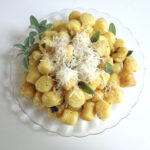 Fluffy gnocchi sautéd with fresh sage in melted butter is one of my go-to dishes when I need to get a quick meal on the table. The butter is browned ever so slightly, enhancing the lusty flavor of the sage, and a topping of freshly grated parmesan adds a delightful tang. This subtle Tuscan-inspired dish is elegant enough to serve for lunch when last-minute guests arrive. And its real beauty is that it takes just five minutes to prepare.
Fluffy gnocchi sautéd with fresh sage in melted butter is one of my go-to dishes when I need to get a quick meal on the table. The butter is browned ever so slightly, enhancing the lusty flavor of the sage, and a topping of freshly grated parmesan adds a delightful tang. This subtle Tuscan-inspired dish is elegant enough to serve for lunch when last-minute guests arrive. And its real beauty is that it takes just five minutes to prepare. Along with rosemary, thyme, basil, lavender and campanula (bellflowers), I bought a small lemon tree, which is rewarding me with lovely white blossoms that I hope will be lemons by the autumn. They have joined my my venerable sage plant, transplanted from the country some years ago and still producing darling new leaves every spring and pale flowers in the summer.
Along with rosemary, thyme, basil, lavender and campanula (bellflowers), I bought a small lemon tree, which is rewarding me with lovely white blossoms that I hope will be lemons by the autumn. They have joined my my venerable sage plant, transplanted from the country some years ago and still producing darling new leaves every spring and pale flowers in the summer.

